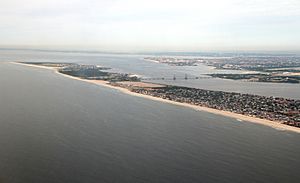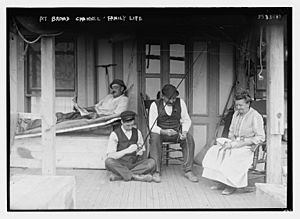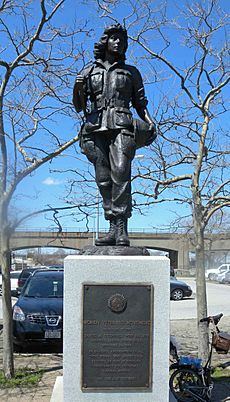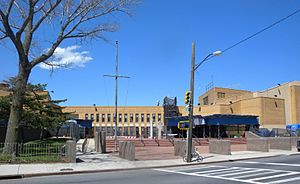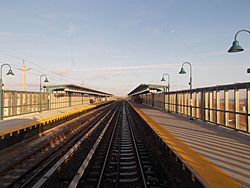Rockaway, Queens facts for kids
Quick facts for kids
Rockaway
|
||
|---|---|---|
|
Neighborhoods of Queens
|
||
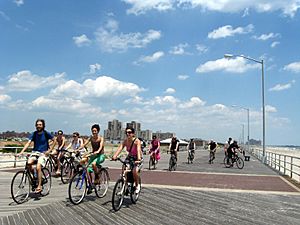
The Rockaway Boardwalk, a visitor attraction on the peninsula
|
||
|
||
| Motto(s): | ||
| Country | ||
| State | ||
| City | ||
| County/Borough | ||
| Community District | Queens 14 | |
| Named for | Corruption of original Lenape language name | |
| Population | ||
| • Estimate
({{{pop_est_as_of}}})
|
124,185 | |
| Time zone | UTC−5 (EST) | |
| • Summer (DST) | UTC−4 (EDT) | |
| ZIP Codes | ||
| Area codes | 718, 347, 929, and 917 | |
The Rockaway Peninsula, often called The Rockaways or just Rockaway, is a long strip of land in Queens, New York City. It's located on the southern edge of Long Island. This area feels a bit separate from busy Manhattan and other city parts. Because of this, Rockaway became a popular summer getaway in the 1830s. Today, it's a mix of different neighborhoods, from quiet family spots to more lively areas. In recent years, it has become a very popular place to live.
The peninsula is split into nine main neighborhoods. Jacob Riis Park sits between two of these sections. From east to west, they are:
- Far Rockaway: from the Nassau County border to Beach 32nd Street.
- Bayswater: located northeast of Far Rockaway, along the southeastern shore of Jamaica Bay.
- Edgemere: from Beach 32nd Street to Beach 56th Street.
- Arverne: from Beach 56th Street to Beach 77th Street.
- Rockaway Beach: from 77th Street to Beach 97th Street.
- Rockaway Park: from Beach 98th Street to Beach 126th Street.
- Belle Harbor: from Beach 126th Street to Beach 141st Street.
- Neponsit: from Beach 141st Street to Beach 149th Street.
- Riis Park: from Beach 149th Street to Beach 169th Street.
- Breezy Point: from Beach 169th Street to the very western tip. This area includes smaller spots like Roxbury and Rockaway Point, plus Fort Tilden.
Rockaway is part of Queens Community Board 14. The New York City Police Department's 100th and 101st Precincts keep the area safe. In 2020, about 124,185 people lived on the peninsula. All ZIP Codes in Rockaway start with 116. The main post office is in Far Rockaway.
Contents
- What's in a Name? The Story of "Rockaway"
- Rockaway's Journey Through Time
- Rockaway Communities
- Who Lives in Rockaway?
- Keeping Rockaway Safe: Fire and Mail Services
- Fun in Rockaway: Parks and Recreation
- Learning in Rockaway: Schools and Libraries
- Getting Around Rockaway: Transportation
- Rockaway in Culture
- Notable People from Rockaway
What's in a Name? The Story of "Rockaway"
The name "Rockaway" likely comes from the Munsee language of the Lenape people. They were Native Americans who lived here in the early 1600s. The name might have meant "place of sands."
Other old spellings include Requarkie and Reckowacky. These were written down by early Dutch and English settlers. The native people of the Rockaways were the Canarsie tribe, a group of Lenape. Their name was linked to the area's geography. "Reckowacky" could also mean "lonely place" or "place of bright waters."
Some other ideas for the name's meaning exist. "Reckonwacky" might mean "the place of our own people." "Reckanawahaha" could mean "the place of laughing waters." Words like "lekau" (sand) and "lechauwaak" (fork or branch) also describe the area's natural features.
Rockaway's Journey Through Time
Early Days and European Arrival
In September 1609, Henry Hudson and his crew were the first Europeans to see the Rockaways. Hudson was looking for a shortcut to Asia, called the Northwest Passage. He sailed into Upper New York Bay and then up the river now named after him.
By 1639, the Mohegan tribe sold most of the Rockaways to the Dutch. In 1664, the English took over the Dutch colony, including this land. In 1685, the local chief, Tackapoucha, and the English governor agreed to sell the Rockaways to Captain Palmer for 31 pounds.
Captain Palmer and the Town of Hempstead argued over who owned Rockaway. So, in 1687, Palmer sold the land to Richard Cornell. Cornell was an iron master from Flushing. He and his family lived on a farm near the Atlantic Ocean. Cornell was buried in a small family cemetery when he died.
The 1800s: Resorts and Growth
In 1808, Cornell's land was divided into 46 smaller pieces. In 1833, a group of rich New Yorkers formed the Rockaway Association. They bought many of these pieces and started building resorts. Rockaway quickly became a popular spot for seaside hotels, with the first one opening in Far Rockaway in 1835.
In the 1800s, people came to Rockaway by horse-drawn carriages or on horseback. A steam-powered ferry also sailed from Lower Manhattan to Brooklyn. The area became even more popular in the 1880s. This was thanks to the Long Island Rail Road (LIRR) building a line to Long Island City and Flatbush Terminal. This made it easier for more people to visit.
In 1878, the community of Bayswater was planned out. One of its first developers was William Trist Bailey. In 1893, a hurricane washed away much of Hog Island. This was a small sandbar island near Far Rockaway. The rest of the island disappeared by 1902. Even today, old plates and other items from the island sometimes wash up on Rockaway Beach.
The Rockaway Peninsula was originally part of the Town of Hempstead. In 1897, the towns of Hammels and Hollands joined together. They became the Village of Rockaway Beach. In 1898, Rockaway joined New York City. This created the new borough of Queens. The village of Rockaway Park also became part of the city on January 1, 1898.
The Early 1900s: "New York's Playground"
In the early 1900s, a new railroad station opened. This made the Rockaways available to many more people, not just the wealthy. Amusement parks, shops, and hotels brought visitors from all over the city. Many people came to spend a day or even a whole summer. This was when Rockaway became known as "New York's Playground."
During this time, Breezy Point started as a neighborhood of summer beach bungalows. These small houses were very popular for summer stays. Some still exist today, updated with modern features. However, most were torn down in the 1960s.
In 1900, a judge ordered land west of Rockaway Park to be sold. Belle Harbor and nearby Neponsit were bought by Edward P. Hatch. He then sold them to the West Rockaway Land Company in 1907. Lots in Belle Harbor were sold in 1915. Frederick J. Lancaster, who developed the Edgemere neighborhood, named Belle Harbor.
In 1905, a group of men formed the Belle Harbor Yacht Club. They bought land from the West Rockaway Land Company for $4,000. By 1908, they were racing against other yacht clubs. In 1912, a new street system was created for the Rockaways. Streets were numbered with "Beach" in front, like Beach 116th Street.
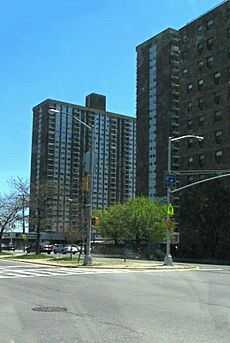
The neighborhoods of Hammels, Arverne, and Far Rockaway tried to leave New York City several times. They felt that joining the city brought high taxes and poor services. In 1915 and 1917, a bill to allow them to leave passed in the state. But the mayor, John Purroy Mitchel, stopped it.
Rockaway's famous amusement park, Rockaways' Playland, opened in 1901. It quickly became a huge attraction. As it grew, rules were made for beachgoers. In 1904, the police captain set rules for bathing suits and where photos could be taken. Women in bathing suits were not allowed to leave the beach area.
The park was very grand for its time. Its roller coaster, the Atom Smasher, was even shown in a movie in 1952. The park also had an Olympic-size swimming pool and a million-dollar midway. It was a popular place for New York families for over 80 years. But in 1985, it closed because of high insurance costs and competition from bigger parks.
Arverne was known for its cheap summer bungalows and hotels. It also had amusements and boardwalk attractions. A grand plan for Arverne included a canal, like in Amsterdam. The canal was never built. Its path became Amstel Boulevard, which is now mostly part of Beach Channel Drive.
The first transatlantic flight started in Neponsit, Rockaway. On May 8, 1919, four U.S. Navy seaplanes took off. They flew to Canada, the Azores Islands, and Portugal. On May 31, 1919, one plane, piloted by Lt. Commander Albert C. Read, finally reached Plymouth, England.
The Robert Moses Era
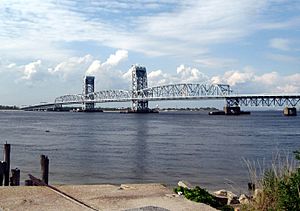
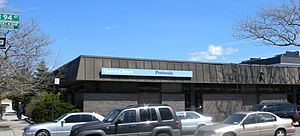
In the 1930s, Robert Moses became New York City's Parks Commissioner. His big road and transportation projects helped and hurt the neighborhood. Moses ordered the building of the Marine Parkway Bridge and the Cross Bay Veterans Memorial Bridge. They were finished in 1937 and 1939.
The Marine Parkway Bridge was built farther west. It connected isolated communities like Jacob Riis Park and Breezy Point to Brooklyn. The Cross Bay Bridge landed in the middle of Rockaway Beach. These bridges helped turn the Rockaways into a place where people lived all year. It was easier for them to travel to work. The old LIRR line also became the Rockaway subway line. This also brought more permanent residents.
Robert Caro, who wrote a book about Robert Moses, said Moses wanted a lot of government-funded housing in the Rockaways.
Moses's other projects also affected the community. He planned to build the Shore Front Parkway in the 1950s and 1960s. This highway would connect Staten Island to the Hamptons. He wanted it to go through the Rockaway Peninsula. The plan was to link the Marine Parkway Bridge with the Atlantic Beach Bridge to Nassau County. It would also connect to the Cross Bay Bridge.
Many people worried this project would harm the peninsula. They saw how Moses's roads had caused problems in the South Bronx. Moses never built his full highway. But a part of it was built in 1939 in Rockaway Park and Rockaway Beach. Houses were cut in half to make way for the four-lane street. Some of these houses are still there. The unfinished street is sometimes called the "road from nowhere to nowhere."
Moses also built other parks and facilities, like the New York Aquarium and Jones Beach State Park. These new places drew tourists away from the Rockaways. With fewer visitors, businesses and hotels closed. By the 1950s, the area faced economic problems. The change from a summer vacation spot to a full-time neighborhood was difficult.
Late 1900s: Changes and Challenges
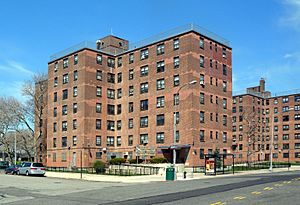
After World War II, many large public housing projects were built in Rockaway. These were part of Moses's city-wide plans. However, some of these projects later faced problems. This caused tension with some of the older residents, many of whom were Irish Catholic. There is also a strong Jewish community in Far Rockaway. For example, the city built the Hammel Houses in Rockaway Beach. This was part of many urban renewal efforts in the area. In 1952, the New York City Housing Authority bought the land. In 1964, they decided to tear down and rebuild the area as a park.
With cheaper travel and air-conditioning, Rockaway lost its appeal as a vacation spot. The area changed into residential communities. Many bungalows became year-round homes for lower-income residents.
In 1960, Breezy Point was sold for $17 million. Residents bought half the land for about $11 million and formed the Breezy Point Cooperative. Apartment building construction started in the late 1960s but was stopped by city rules. In Arverne, a large area was set aside for renewal in 1964. But for 30 years, it remained mostly undeveloped.
In 1998, a parade in Broad Channel included a float that caused controversy. It made fun of a serious event. City workers involved were fired but later sued the city. The case went to court, causing a lot of discussion about the town's image.
The 2000s: New Life and Disasters
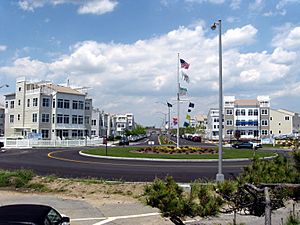
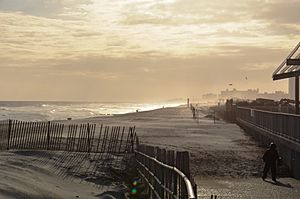
For decades, big plans for casinos or sports arenas in Rockaway didn't happen. But in 2002, planning began for a large empty area between Rockaway Beach and Arverne. By 2004, people started moving into the first buildings of the Arverne-By-the-Sea development. By 2012, it had about 2,300 homes. This also led to new shops opening nearby.
Along the beach, old zoning laws for hotels allowed developers to build tall buildings. These high-rises appeared next to smaller, older homes. To stop this, some communities approved new zoning plans. These plans limit the size of new buildings.
Some people worried that the growing population would strain the area's services. They also pointed to environmental concerns. Others argued that new development would help the economy. They believed services could be improved once more people lived there. In 2008, the New York City Council approved a rezoning plan. It limited building sizes in five Rockaway communities.
More people are moving to the city, making the Rockaways a popular day trip. In 2007, New York Magazine featured it as a place for "male bonding" and "scuba diving for sunken ships." Today, the beaches are well-kept and still draw crowds in summer. Jacob Riis Park and Fort Tilden are at the western end. They are part of the Gateway National Recreational Area, one of the first urban national parks.
The 5.5 miles (8.9 km) long Rockaway Boardwalk and 170 acres (0.69 km2) of sandy beaches are easy to reach by subway. This makes them popular for summer day trips. At the western end of the boardwalk, some beach areas are fenced off. This protects nesting birds like terns and plovers, making it a unique place for birdwatching.
After 2010, the Rockaways became very popular again. News reports mentioned artists buying homes on the beach. The peninsula was even called "Williamsburg on the Rockaways." This was because surfers from Williamsburg started spending summers there. Many businesses opened to serve these visitors. There's even a summer shuttle bus from Williamsburg to the Rockaways.
In February 2016, The New York Times featured the Rockaway Peninsula as one of "New York's Next Hot Neighborhoods."
Disasters and Major Events
19th and 20th Century Challenges
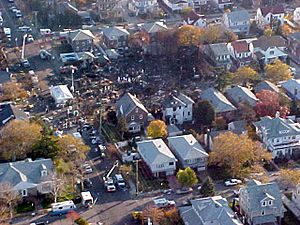
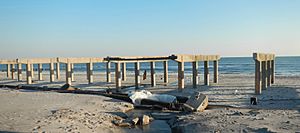
Storms and fires caused a lot of damage to Rockaway's attractions in the late 1800s and early 1900s. On August 24, 1893, a strong storm, later called a hurricane, destroyed Hog Island. This island had bath houses and restaurants. On January 3, 1914, a violent storm swept the 1,200-seat Arverne Pier Theater out to sea. On June 15, 1922, a fire destroyed much of Arverne. About 10,000 people lost their homes, but the neighborhood rebuilt quickly.
On June 6, 1993, a ship called the Golden Venture landed near Fort Tilden. It carried 296 Chinese immigrants. Ten people died trying to reach the shore.
2001 Tragedies
Over 70 Rockaway residents died in the September 11 attacks on the World Trade Center in 2001. This included people who worked there and firefighters. The city later opened Tribute Park in their memory. In the park's center is a piece of twisted steel from the Twin Towers. Ceremonies are held there every September 11th.
Almost two months after 9/11, on November 12, 2001, American Airlines Flight 587 crashed in Belle Harbor. All 260 people on the plane died, plus five on the ground. Many passengers were from the Dominican community in Washington Heights. A temporary memorial was set up at the crash site. Later, a public memorial was built at the south end of Beach 116th Street. Ceremonies are held there every November 12th.
A resident told The Guardian in 2001 that it was common for families to live in the same houses for generations. The community suffered greatly from both the 9/11 attacks and Flight 587. The book Braving the Waves: Rockaway Rises, and Rises Again by Kevin Boyle tells personal stories of Rockaway residents during these events.
Hurricane Sandy's Impact
In October 2012, Hurricane Sandy caused huge damage to Rockaway. Many homes, especially in Breezy Point, were destroyed by high water or fires. Firefighters had trouble reaching the area due to flooding. Residents lost everything in their basements, and hundreds of cars were ruined.
During the storm, a fire spread quickly through Breezy Point's closely spaced houses. It destroyed 126 homes and damaged 22 more. Thousands of other houses were damaged by flooding. Fires also hit Beach 130th Street in Belle Harbor and shops near Beach 114th Street in Rockaway Park. Large parts of the Rockaway Boardwalk were washed away. The FDNY found 130 homes burned to the ground. Another 50 homes were damaged by fire. An official report said rising seawater caused the fire by touching electrical wires. "Whalemina," a large whale statue and beloved symbol of Rockaway, disappeared from Beach 94th Street. It was believed to have been swept into the sea.
On August 4, 2013, Senator Charles Schumer announced that the first phase of beach reconstruction was done. The federal government paid for it through the Hurricane Sandy relief bill.
Rockaway Communities
- Arverne: between Beach 56th Street and Beach 79th Street.
- Bayswater: northeast of Far Rockaway, along Jamaica Bay.
- Belle Harbor: between Beach 126th Street and Beach 141st Street.
- Breezy Point: on the westernmost part of the Rockaways, west of Fort Tilden.
- Broad Channel: not on the peninsula itself, but just north of the Cross Bay Veterans Memorial Bridge.
- Edgemere: between Beach 32nd Street and Beach 56th Street.
- Far Rockaway: between the Nassau County line and Beach 32nd Street.
- Hammels: along Beach 84th Street; also extends to Beach 79th Street.
- Neponsit: between Beach 142nd Street and Beach 149th Street.
- Rockaway Beach: between Beach 73rd Street and Beach 108th Street.
- Rockaway Park: between Beach 105th Street and Beach 126th Street.
- Roxbury: west of Marine Parkway Bridge, on the north side of Beach Channel Drive.
- Seaside: between Beach 84th Street and Beach 105th Street.
Who Lives in Rockaway?
Based on the 2010 United States Census, Rockaway and Broad Channel had 114,961 people. This was an increase of 8,261 (7.2%) from 2000. The area covers about 4,758.96 acres (1,925.88 ha).
The population was 35.2% White, 38.9% African American, 0.3% Native American, 2.2% Asian, and 0.1% Pacific Islander. About 21% of the population was Hispanic or Latino.
In 2018, the Rockaways and Broad Channel had 114,390 residents. The average life expectancy was 76.5 years. Most residents are middle-aged adults and young people. About 26% are under 18, 25% are 25–44, and 26% are 45–64.
In 2017, the average household income was $54,012. In 2018, about 18% of Rockaway residents lived in poverty. About 9% of residents were unemployed. About 53% of residents have trouble paying their rent.
Keeping Rockaway Safe: Fire and Mail Services
Fire Safety
The New York City Fire Department (FDNY) has several fire stations in Rockaway:
- Engine Company 329: 402 Beach 169th Street
- Engine Company 268/Ladder Company 137: 257 Beach 116th Street
- Engine Company 266: 92-20 Rockaway Beach Boulevard
- Engine Company 265/Ladder Company 121/Battalion 47/EMS Station 47: 303 Beach 49th Street
- Engine Companies 264 and 328/Ladder Company 134: 16-15 Central Avenue
Post Offices and ZIP Codes
Rockaway has several ZIP Codes:
- 11697: Breezy Point
- 11694: Rockaway Park
- 11693: Broad Channel
- 11692: Arverne
- 11691: Far Rockaway
The United States Post Office has four locations in Rockaway:
- Arverne Station: 329 Beach 59th Street
- Far Rockaway Station: 18-36 Mott Avenue
- Rockaway Station: 113-25 Beach Channel Drive
- Rockaway Beach Station: 90-14 Rockaway Beach Blvd
Fun in Rockaway: Parks and Recreation
The western part of the Rockaway Peninsula is in the Gateway National Recreation Area. The National Park Service runs three sites here. Jacob Riis Park is near the western end, covering about 262 acres (106 ha) west of Beach 149th Street. Fort Tilden has historic military buildings west of Jacob Riis Park. Breezy Point Tip is a 200-acre (0.81 km2) beach that is also a wildlife breeding area.
NYC Parks manages city-owned parks. Rockaway Beach and Boardwalk stretches almost seven miles from Beach 9th to Beach 149th Streets. Along the beach and boardwalk, you'll find playgrounds, restrooms, sports fields, and food stands. Rockaway Beach is New York City's only open-ocean surfing beach. There are surfing areas at Beach 69, Beach 90, and Beach 110 Streets. Surf lessons are offered at Beach 69th Street.
There are also three wildlife sanctuaries: Dubos Point, Brant Point, and Vernam Barbadoes Preserve. Other parks include Beach Channel Park, Tribune Park (a 9/11 memorial), Rockaway Community Park, and Bayswater Park. In Arverne, there are plans to turn an empty lot into Thursby Basin Park.
The New York State Office of Parks, Recreation and Historic Preservation runs one state park, Bayswater Point State Park. It's in Bayswater, next to NYC Parks' Bayswater Park.
Learning in Rockaway: Schools and Libraries
Rockaway generally has fewer college-educated residents than the rest of New York City. In 2018, 35% of adults aged 25 and older had a college education or higher. About 22% had less than a high school education.
More elementary school students in Rockaway miss school compared to the rest of New York City. About 29% of elementary students missed 20 or more days per school year. However, 71% of high school students in Rockaway graduate on time.
Public Elementary and Middle Schools
- P.S./M.S. 42 Robert Vernam
- P.S./M.S. 43 The School by the Sea
- P.S. 47 Chris Galas
- P.S. 104 The Bayswater School
- P.S. 105 The Bay School
- P.S. 106 Light House Elementary School
- P.S./M.S. 114 The Belle Harbor School
- P.S./M.S. 183 Dr. Richard Green
- P.S. 197 The Ocean School
- P.S. 253 The Randolph Holder School for Social Justice
- P.S. 256
- M.S. 53 Brian Piccolo
- M.S./H.S. 323 Scholars' Academy
Public High Schools
- Scholars' Academy
- Channel View School for Research
Private Schools
- Beth El Temple
- Chaim Berlin High School
- Hebrew Academy of the Five Towns and Rockaway (HAFTR)
- Mesivta Chaim Shlomo
- Bnois Bais Yaacov
- Tichon Meir Moshe
- Sh'or Yoshuv Institute of Jewish Studies
- Siach Yitzchok Elementary School for Boys
- Torah Academy for Girls
- West End Temple
- Yeshiva Darchei Torah
- Yeshiva of Far Rockaway
- The Hebrew Institute of Long Island
- Yeshiva Bnei Torah
- St. Francis de Sales
- St. Camillus
- St. Rose of Lima Catholic Academy
- Church Of God Christian Academy
- St. Mary Star of the Sea
- Nikitas Language Abroad Schools
Synagogues
- Agudath Israel of Long Island
- Agudath Israel of Rockaway
- Agudath Israel of West Lawrence
- Bayswater Jewish Center
- Beis Medrash Ateres Yisroel (Rabbi Avraham Blumenkranz)
- Bnos Israel Institute (Rabbi Shmelke Rubin)
- Congregation Kneseth Israel in Far Rockaway
- Congregation Shaarey Tefila
- Congregation Shaarey Zedek
- Congregation Shomrai Shabbos
- Young Israel of Far Rockaway
- Young Israel of Wavecrest and Bayswater
Libraries
Queens Public Library has four branches in Rockaway:
- The Arverne branch: 312 Beach 54th Street
- The Far Rockaway branch: 1003 Beach 20th Street (a new building is being constructed)
- The Peninsula branch: 92-25 Rockaway Beach Boulevard
- The Seaside branch: 116-15 Rockaway Beach Boulevard
Getting Around Rockaway: Transportation
Rockaway has many ways to get around.
Trains and Subways
The New York City Subway's IND Rockaway Line has two branches. The eastern branch, served by the A train train, goes to Far Rockaway–Mott Avenue station. The western branch, served by the A S trains train, goes to Rockaway Park–Beach 116th Street station. This western line used to be part of the Long Island Rail Road (LIRR).
The Far Rockaway station is the end of the LIRR's Far Rockaway Branch. This line used to go across Jamaica Bay and connect to other LIRR lines. But fires and maintenance problems caused the LIRR to stop using that part of the route. The city then bought it to create the IND Rockaway Line subway.
Buses
MTA Regional Bus Operations runs local buses like the Q22, Q35, Q52/Q53 SBS, Q113, Q114. There are also express buses to Manhattan, the QM16, QM17. The Nassau Inter-County Express (NICE) also has routes n31, n32, n33 in Far Rockaway. These NICE buses allow riders to travel only within Far Rockaway. There are also private shuttle buses like NYC Beach Bus and Rockabus from Brooklyn.
Ferry
After Hurricane Sandy in 2012, a ferry service started. It ran between Beach 108th Street in Rockaway Park and Manhattan. It also stopped at the Brooklyn Army Terminal. This service was extended several times. On May 1, 2017, NYC Ferry started its Rockaway route. It connects Beach 108th Street to Manhattan, with a stop at Brooklyn Army Terminal.
Rockaway in Culture
The Rockaway Arts Council hosts many events. Two art groups, the Rockaway Theater Company and the Rockaway Artists' Alliance, often perform at Fort Tilden.
Rockaway has appeared in many books, movies, and songs:
- Lawrence Ferlinghetti's poetry collection Far Rockaway of the Heart (1998).
- Boardwalk Empire, an HBO series, filmed parts of its show at Fort Tilden and the Boardwalk.
- Jill Eisenstadt's novel From Rockaway (1987) is about lifeguards in the 1980s. Her 2017 novel, Swell, brings back some of the same characters.
- Folk singer Christine Lavin wrote the song "Rockaway" about her family home there.
- Woody Allen's movie Radio Days (1987) was filmed in Rockaway Park.
- Patricia Reilly Giff's novel Lily's Crossing (1998) is set in the Rockaways during World War II.
- Naomi Ragen's novel Chains Around the Grass (2002) is set in a Rockaway public housing project.
- The 2010 documentary Our Hawaii explores the surf culture in Rockaway.
- The TV show NYPD Blue mentioned Far Rockaway as a quiet place for police work.
- On The Marvelous Mrs. Maisel, a character is from Broad Channel Avenue in the Rockaways.
- The Ramones' song "Rockaway Beach" (1977) was a big hit. The band's bassist, Dee Dee Ramone, loved spending time on the beach there. In 2013, the song was used in ads to promote Rockaway's beaches after Hurricane Sandy.
Notable People from Rockaway
- Alexa Naas (born 1989), a mixed-race tech leader, was born and raised in Rockaway Beach.



